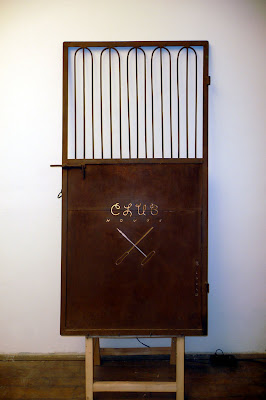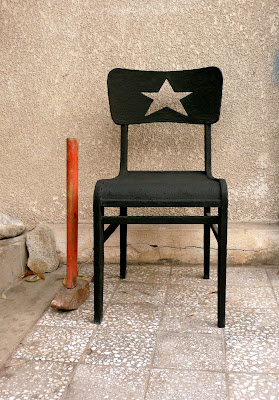
luni, 28 decembrie 2009
miercuri, 16 decembrie 2009
sâmbătă, 5 decembrie 2009
vineri, 4 decembrie 2009
Teodor Graur (art author):
Based in Bucharest - Romania, the author are working in contemporary art, since the early 80s. He used chiefly, the installation - especially in events held in the underground. The censorship exercised by the totalitarian regime made some performance works to be done only in private space. For example: "Bridge" (1986, Bucharest - Budapest), "Europia" (1986, Sibiu - Romania), "The Amateur Sportsman" (1987, Bucharest), "Remember the Ship" (Costinesti - Romania). In 1988 the artist went on a trip to China and Mongolia ( "Go East 88").
In the summer of 1989, under the impulse of a misgiving feeling, for what would happen in December - the fall of Ceausescu's communist regime – he painted a triptych, using the national colors: blue - yellow - red ( "89"). This work was public exhibited next year, within the show ”Teodor Graur’s Museum”, in Bucharest.
In the 90s, T. G. continued to operate freely. He started to work series: "Star" (1992, text "The Star Maker"). "Speaking to Europe" (performance, 1994, Timisoara - Romania). In the same year, he founded the group "Euroartist Bucureşti” (Olimpiu Bandalac & Teodor Graur) that comments by staged photo, the Romanian socio-cultural context. In 1998 there was a short collaboration with the National Academy of Art Bucharest - the alternative class STUDIO498. In the early 2000 the artist took part in international exhibitions focused on the Balkans. Other serial works apeared: "Grey - Made in Romania" (2000), "Culture - Product of Europe” (2004). Between 2003 -2007, T. G. organized and led HT003 Gallery, which "exposed contemporary art for the public’s education." Until recently, the artist was interested in the Eastern European and the Romanian context, commenting and polemizing with official art and institutions, with attitudes of ordinary people. After 2008, he abandoned this approach, considering the end of the totalitarian East European issues; now, a concern with the sculpture and the object is coming out, especially for middle of the 20th century modernism, in object design, and also involving the postmodern comment.
“The art of the 20th century started with revolution and vanguard, denying traditional art. The new trends have been called modern art. At the mid century, after the World War II, - along with the reconstruction - the general context was the new modernism, which artists fervently cultivated, following guiding principles, such as functionalism, or the purity of means in visual arts - even when they lived under totalitarian regime. The East European artists have tried to combat the state ideology – the socialist realism - in order to find the first vanguard modernist vein, synchronic with the Western world. In my country, in the 60s, modernist style was repudiated by the authorities as being of Western origin; then, when some local achievements occurred, they were overlooked, like belonging to communism (as happened in the 20s, with the Bauhaus School, finally closed by the national-socialist regime in 1933). Therefore, we hadn’t a debate on Modernism, neither in the better days, nor even today. To discover now typical forms and objects and artistically comment it – that’s an appealing adventure for the artist!
The Modernism remains a model of heroism and romance. Because people believed in the perfection of the new, that would lead to a superior civilization. Today we know that was just an illusion. And we mock at this, with postmodern irony.”
T. G.
In the summer of 1989, under the impulse of a misgiving feeling, for what would happen in December - the fall of Ceausescu's communist regime – he painted a triptych, using the national colors: blue - yellow - red ( "89"). This work was public exhibited next year, within the show ”Teodor Graur’s Museum”, in Bucharest.
In the 90s, T. G. continued to operate freely. He started to work series: "Star" (1992, text "The Star Maker"). "Speaking to Europe" (performance, 1994, Timisoara - Romania). In the same year, he founded the group "Euroartist Bucureşti” (Olimpiu Bandalac & Teodor Graur) that comments by staged photo, the Romanian socio-cultural context. In 1998 there was a short collaboration with the National Academy of Art Bucharest - the alternative class STUDIO498. In the early 2000 the artist took part in international exhibitions focused on the Balkans. Other serial works apeared: "Grey - Made in Romania" (2000), "Culture - Product of Europe” (2004). Between 2003 -2007, T. G. organized and led HT003 Gallery, which "exposed contemporary art for the public’s education." Until recently, the artist was interested in the Eastern European and the Romanian context, commenting and polemizing with official art and institutions, with attitudes of ordinary people. After 2008, he abandoned this approach, considering the end of the totalitarian East European issues; now, a concern with the sculpture and the object is coming out, especially for middle of the 20th century modernism, in object design, and also involving the postmodern comment.
“The art of the 20th century started with revolution and vanguard, denying traditional art. The new trends have been called modern art. At the mid century, after the World War II, - along with the reconstruction - the general context was the new modernism, which artists fervently cultivated, following guiding principles, such as functionalism, or the purity of means in visual arts - even when they lived under totalitarian regime. The East European artists have tried to combat the state ideology – the socialist realism - in order to find the first vanguard modernist vein, synchronic with the Western world. In my country, in the 60s, modernist style was repudiated by the authorities as being of Western origin; then, when some local achievements occurred, they were overlooked, like belonging to communism (as happened in the 20s, with the Bauhaus School, finally closed by the national-socialist regime in 1933). Therefore, we hadn’t a debate on Modernism, neither in the better days, nor even today. To discover now typical forms and objects and artistically comment it – that’s an appealing adventure for the artist!
The Modernism remains a model of heroism and romance. Because people believed in the perfection of the new, that would lead to a superior civilization. Today we know that was just an illusion. And we mock at this, with postmodern irony.”
T. G.
Abonați-vă la:
Postări (Atom)

















